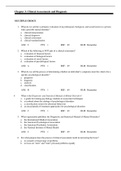Exam (elaborations)
University of Guelph| PSYCH 3390 Test Bank Chapter 3: Clinical Assessments and Diagnosis|1-50 Complete Solutions
- Course
- Institution
University of Guelph| PSYCH 3390 Test Bank Chapter 3: Clinical Assessments and Diagnosis|1-50 Complete Solutions
[Show more]



